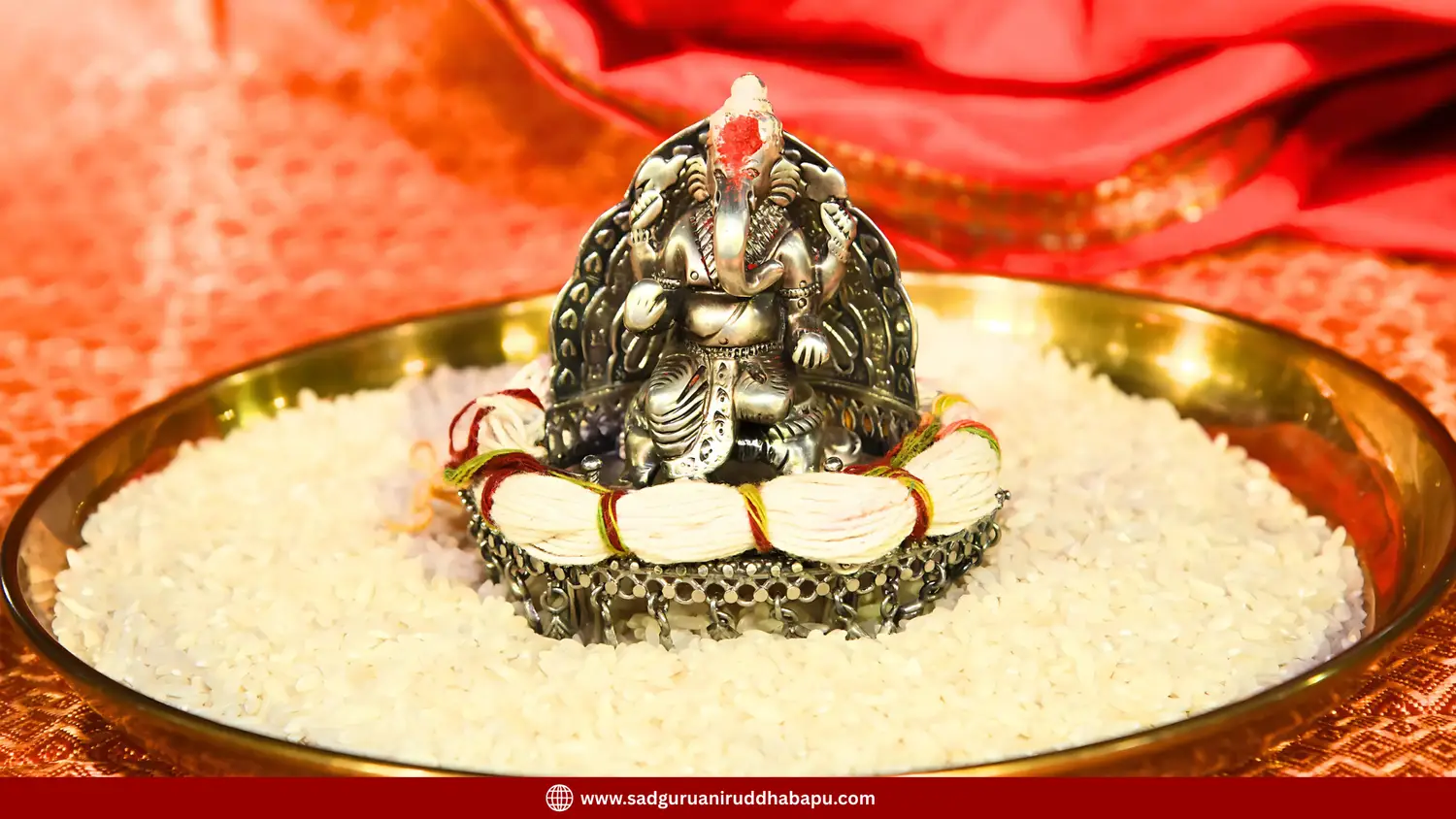Explanation of the Adya Brahmanaspati Sukta, that is, the 18th Sukta of the First Mandala of the Rigveda

मराठी हिंदी ગુજરાતી বাংলা తెలుగు தமிழ் ಕನ್ನಡ മലയാളം
Reference – ‘Tulsipatra 854’ - an editorial written by Sadguru Shree Aniruddha Bapu, based on the Sundarkand of Shreeramcharitmanas composed by the eminent saint Shree Tulsidasji, in Dainik Pratyaksha dated (24-06-2012).
In his editorial on the Sundarkand dated 24-06-2012, that is, Tulsipatra 854, Sadguru Shree Aniruddha briefly explained the 18th Sukta of the First Mandala of the Rigveda, known as the Ādya Brahmanaspati Sukta, in accordance with the promise given by Brahmarshi Shyavashva Atreya to Uddālaka. The explanation is presented in a manner that is very easy to understand.
Tulsipatra 854
सुनत बिनीत बचन अति कह कृपाल मुसुकाइ । जेहि बिधि उतरै कपि कटकु तात सो कहहु उपाइ ॥३३४॥
Sunat binit bachan ati kaha krupal musukai |
Jehi bidhi utarai kapi kataku taat so kahahu upai ||334||
Hearing the extremely humble words of the sea, the gracious Shri Ram smiled and said, “Dear Father, please tell me a way by which the Vanara army can cross the sea.”
9. Kirata-kaal
According to the promise given to Uddalaka, Brahmarshi Shyavashva Atreya began to recite and explain the 18th Sukta of the First Mandala of the Rigveda, which is renowned as the Adya Brahmanaspati Stotra.

Sukta 18
1. सोमानं स्वरणं कृणुहि ब्रह्मणस्पते कक्षीवन्तं यः औशिजः॥ (“Somanam svaranam krunuhi brahmanaspate kakshivantam yah aushijaha )
O Brahmanaspati, Master of Knowledge! Just as You made Kakṣīvān Auśija, radiant and brought about his supreme progress, in the same way, lead an insignificant devotee like me, who sings stotra in Your praise, on the path of progress.
2. यः रेवान् यः अमीवहा वसुवित् पुष्टिवर्धनः सः नः सिषुक्तु यः तुरः॥ (Yah revan yah amīvaha vasuvit pushtivardhanaḥ sa naḥ sishuktu yah turah)
O Brahmanaspati! You are Revan, meaning the one who can bestow every form of wealth and opulence; You are Vasuvit meaning the most generous benefactor; You are Puṣṭivardhana meaning the One who increases strength and vitality; and You are Turaḥ meaning the One who accomplishes every task swiftly. Therefore, shower Your grace upon us without delay.
3. मा नः शंसः अररुषः धूर्तिः प्रणङ् मर्त्यस्य रक्ष नः ब्रह्मणस्पते॥ (Maa nah shansah ararushah dhurtih pranan martyasya raksha nah brahmanaspate)
O Brahmanaspati! May the words and wicked deeds of deceitful enemies never harm us. Protect us from every side and guard us always.
4. सः ध वीरः न रिष्यति यं इन्द्रः ब्रह्मणस्पतिः सोमः हिनोति मर्त्यं॥ (sah dha virah na rishyati yam indrah brahmanaspatih somah hinoti martyam)
That devotee upon whom Indra, Brahmanaspati, and Soma bestow their grace is neither ruined nor weakened.
5. त्वं तं ब्रह्मणस्पते सोमः इन्द्रः च मर्त्यं दक्षिणा पातु अंहसः॥
(Tvam tam brahmanaspate somah indrah cha martyam dakshina patu amhasah)
Meaning:
O Brahmanaspati! I humbly pray that, together with Indra, Soma, and Dakshina (the daughter of Daksha Prajapati), You protect the devotee by saving him from his sins.
6. सदसः पतिं अद्भुतं प्रियं इन्द्रस्य काम्यं सनिं मेधां अयासिषं॥
(Sadasah patim adbhutam priyam indrasya kamyam sanim medham ayasisham)
O Brahmanaspati! You are the authority of all gatherings; wherever a group is formed, You preside and control over the sense of collective spirit within them. You are the wondrous benefactor capable of fulfilling the wishes of everyone in a group of devotees at the same time. You are very dear to KiratRudra. I pray to you that my Medha i.e., my intellect remains sharp.

7. यस्मात् ऋते न सिध्यति यः विपश्चितः च न सः धीनां योगं इन्वति॥
(Yasmaat rute na sidhyati yah vipashchitah cha na sah dhinam yogam invati)
Without whose support and help neither the penance of ascetics, nor the yadnyas of Gayatri worshippers, nor the pursuit of the knowledge by the learned and wise can succeed — may that Brahmanaspati constantly inspire our wisdom.
This verse is referred to as the Dnyanasadhana Gayatri. By the observance of its practice, three things are attained:
a) The seeker’s intellect becomes sharp and strong.
b) His ability to comprehend meaning continues to grow.
c) No matter how knowledgeable he becomes, he remains humble and surrendered to the Chandika family.
8. आत् ऋध्नोति हविष्कृतिं प्रांचं कृणोति अध्वरं होत्रा देवेषु गच्छति॥
(Aat Ruddhnoti havishkrutim prancham krunoti adhvaram hotra deveshu gachchati)
This great Brahmanaspati continuously brings about the progress of those who perform yadnyas and of farmers. It is He who brings every kind of yadnya to perfect completion. It is He who renders our speech that praises the Parmatma meaningful.
9. नराशंसं सुधृष्टमं अपश्यं स प्रथस्तमं दिवः न सद्म-मखसं॥
(Narashamsam sudhrushtam apashyam sa prathastamam divah na sadma-makhasam)
I saw Brahmanaspati, who is more radiant than the sun, who is extremely valiant, who performs any task with ease, who is exceedingly dear to his devotees, and who is always worshipped first by humans; and I was fulfilled by his darshan.
At the end of the editorial Sadguru Shree Aniruddha Bapu writes,
My dear Shraddhavan friends, during the worship and darshan of the Ashtavinayak, we worship the form of Gauriputra (the son of Gauri) who is, in fact, the manifestation of the oneness of Brahmanaspati, the son of Kiratrudra as well as Ganapati, the son of Paramshiva.

